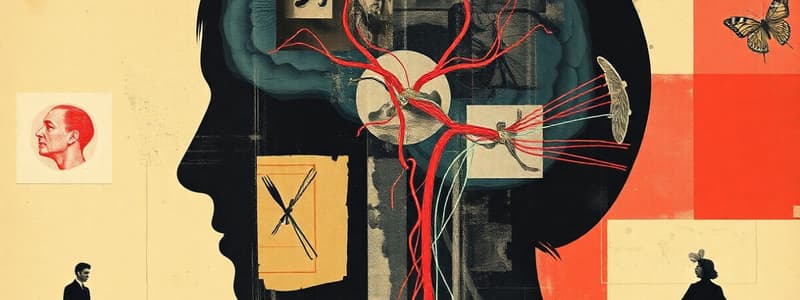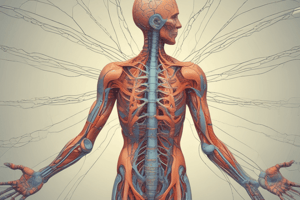Podcast
Questions and Answers
What is the primary role of the midline of the cerebellum?
What is the primary role of the midline of the cerebellum?
- Coordinating middle body movement and walking (correct)
- Processing sensory information
- Regulating eye movement
- Coordinating limb movements
Which structure is responsible for connecting the right and left cerebral hemispheres?
Which structure is responsible for connecting the right and left cerebral hemispheres?
- Internal capsule
- Basal ganglia
- Corpus callosum (correct)
- Thalamus
What important pathways does the internal capsule contain?
What important pathways does the internal capsule contain?
- Pons pathways
- Sensorimotor pathways
- Cranial nerve tracts
- Corticospinal tract (correct)
What is the role of the reticular formation located in the brainstem?
What is the role of the reticular formation located in the brainstem?
Which of the following accurately describes the basal ganglia?
Which of the following accurately describes the basal ganglia?
Which receptors are responsible for detecting pain and temperature?
Which receptors are responsible for detecting pain and temperature?
What is a characteristic of mechanoreceptors in terms of their axon structure?
What is a characteristic of mechanoreceptors in terms of their axon structure?
What role do lower motor neurons (LMNs) play in muscle reflexes?
What role do lower motor neurons (LMNs) play in muscle reflexes?
What is the primary function of muscle spindles?
What is the primary function of muscle spindles?
Where is gray matter located in the spinal cord in comparison to white matter?
Where is gray matter located in the spinal cord in comparison to white matter?
What occurs during the knee jerk reflex?
What occurs during the knee jerk reflex?
What distinguishes upper motor neurons (UMNs) from lower motor neurons (LMNs)?
What distinguishes upper motor neurons (UMNs) from lower motor neurons (LMNs)?
Which sensory modality is associated with mechanoreceptors?
Which sensory modality is associated with mechanoreceptors?
What is the primary role of the corticospinal tract?
What is the primary role of the corticospinal tract?
Which of the following is NOT classified as an upper motor sign?
Which of the following is NOT classified as an upper motor sign?
What distinguishes the corticobulbar tract from the corticospinal tract?
What distinguishes the corticobulbar tract from the corticospinal tract?
Which response is characteristic of the extensor plantar response?
Which response is characteristic of the extensor plantar response?
Which neurotransmitter is considered the most common excitatory neurotransmitter in the brain?
Which neurotransmitter is considered the most common excitatory neurotransmitter in the brain?
What type of sensory information is primarily handled by the second category of somatosensory tracts?
What type of sensory information is primarily handled by the second category of somatosensory tracts?
What is the primary role of GABA in the central nervous system?
What is the primary role of GABA in the central nervous system?
Which structure is responsible for releasing norepinephrine?
Which structure is responsible for releasing norepinephrine?
Which lobe of the brain is primarily responsible for somatosensory processing?
Which lobe of the brain is primarily responsible for somatosensory processing?
Which type of lesion involves cooling neurons to stop them from firing?
Which type of lesion involves cooling neurons to stop them from firing?
How does injury to one side of the brain typically impact sensory processing?
How does injury to one side of the brain typically impact sensory processing?
Which method is used to observe the structural anatomy of the brain?
Which method is used to observe the structural anatomy of the brain?
Which area of the brain is associated with the coordination of movement and receives position sense information?
Which area of the brain is associated with the coordination of movement and receives position sense information?
What is the main effect of excitotoxic lesions on neurons?
What is the main effect of excitotoxic lesions on neurons?
Which of the following neurotransmitters is released by the raphe nuclei?
Which of the following neurotransmitters is released by the raphe nuclei?
What distinguishes neurochemical lesions from other lesioning techniques?
What distinguishes neurochemical lesions from other lesioning techniques?
What is a primary advantage of MEG over EEG?
What is a primary advantage of MEG over EEG?
Which imaging technique provides information about blood flow in the brain?
Which imaging technique provides information about blood flow in the brain?
What distinguishes monozygotic twins from dizygotic twins?
What distinguishes monozygotic twins from dizygotic twins?
What is the main focus of twin studies in psychology?
What is the main focus of twin studies in psychology?
In the context of temperament, how is it different from personality?
In the context of temperament, how is it different from personality?
Which statement about the influence of heredity is accurate?
Which statement about the influence of heredity is accurate?
What is a common misconception about the environmental influences on identical twins?
What is a common misconception about the environmental influences on identical twins?
What can be inferred from similar rates of schizophrenia in both monozygotic and dizygotic twins?
What can be inferred from similar rates of schizophrenia in both monozygotic and dizygotic twins?
What is the primary focus of ethology in the study of behavior?
What is the primary focus of ethology in the study of behavior?
Which of the following best defines innate behavioral traits?
Which of the following best defines innate behavioral traits?
How do learned behavioral traits differ from innate traits?
How do learned behavioral traits differ from innate traits?
What characterizes reflex behaviors?
What characterizes reflex behaviors?
Which of the following statements about negative feedback is true?
Which of the following statements about negative feedback is true?
What distinguishes complex behaviors from innate and learned behaviors?
What distinguishes complex behaviors from innate and learned behaviors?
Which of the following best illustrates a consummate behavior?
Which of the following best illustrates a consummate behavior?
How is positive feedback typically characterized?
How is positive feedback typically characterized?
Flashcards
Corticospinal Tract
Corticospinal Tract
A collection of axons from upper motor neurons (UMNs) that travel from the cerebral cortex to the spinal cord, where they cross to the opposite side and synapse on lower motor neurons (LMNs).
Corticobulbar Tract
Corticobulbar Tract
A collection of axons from upper motor neurons (UMNs) that travel from the cerebral cortex to the brainstem, where they synapse on lower motor neurons (LMNs) that control cranial nerves.
Hyperreflexia
Hyperreflexia
An exaggerated muscle stretch reflex, usually caused by increased sensitivity of muscle spindle receptors due to lack of UMN stimulation
Clonus
Clonus
Signup and view all the flashcards
Hypertonia
Hypertonia
Signup and view all the flashcards
Extensor Plantar Response
Extensor Plantar Response
Signup and view all the flashcards
Somatosensory Pathway (Fine Touch)
Somatosensory Pathway (Fine Touch)
Signup and view all the flashcards
Somatosensory Pathway (Pain & Temperature)
Somatosensory Pathway (Pain & Temperature)
Signup and view all the flashcards
What are the five main senses of somatosensation and their corresponding receptors?
What are the five main senses of somatosensation and their corresponding receptors?
Signup and view all the flashcards
How do the axon sizes and myelination differ between mechanoreceptors and nociceptors/thermoreceptors?
How do the axon sizes and myelination differ between mechanoreceptors and nociceptors/thermoreceptors?
Signup and view all the flashcards
How does the transmission of touch information vary?
How does the transmission of touch information vary?
Signup and view all the flashcards
Where are mechanoreceptors located in the body?
Where are mechanoreceptors located in the body?
Signup and view all the flashcards
How do pain and temperature receptors differ in structure from mechanoreceptors?
How do pain and temperature receptors differ in structure from mechanoreceptors?
Signup and view all the flashcards
What is the direction of information flow in afferent axons?
What is the direction of information flow in afferent axons?
Signup and view all the flashcards
What is a muscle stretch reflex?
What is a muscle stretch reflex?
Signup and view all the flashcards
Explain the process of the knee-jerk reflex.
Explain the process of the knee-jerk reflex.
Signup and view all the flashcards
Reticular formation
Reticular formation
Signup and view all the flashcards
Long tracts
Long tracts
Signup and view all the flashcards
Internal capsule
Internal capsule
Signup and view all the flashcards
Corpus callosum
Corpus callosum
Signup and view all the flashcards
Basal ganglia
Basal ganglia
Signup and view all the flashcards
Epigenetics
Epigenetics
Signup and view all the flashcards
Adaptive Value of Behavior
Adaptive Value of Behavior
Signup and view all the flashcards
Ethology
Ethology
Signup and view all the flashcards
Glutamate
Glutamate
Signup and view all the flashcards
GABA and Glycine
GABA and Glycine
Signup and view all the flashcards
Acetylcholine
Acetylcholine
Signup and view all the flashcards
Histamine
Histamine
Signup and view all the flashcards
Norepinephrine
Norepinephrine
Signup and view all the flashcards
Serotonin
Serotonin
Signup and view all the flashcards
Dopamine
Dopamine
Signup and view all the flashcards
Lesion Studies
Lesion Studies
Signup and view all the flashcards
Magnetoencephalography (MEG)
Magnetoencephalography (MEG)
Signup and view all the flashcards
Functional Magnetic Resonance Imaging (fMRI)
Functional Magnetic Resonance Imaging (fMRI)
Signup and view all the flashcards
Positron Emission Tomography (PET)
Positron Emission Tomography (PET)
Signup and view all the flashcards
Temperament
Temperament
Signup and view all the flashcards
Heredity
Heredity
Signup and view all the flashcards
Classical Twin Study
Classical Twin Study
Signup and view all the flashcards
Adoption Studies
Adoption Studies
Signup and view all the flashcards
Twin Studies and Schizophrenia
Twin Studies and Schizophrenia
Signup and view all the flashcards
Study Notes
Peripheral Somatosensation
- Somatosensation includes five main types: position sense, vibration, touch, pain, and temperature.
- Position, vibration, and touch are mechanoreceptors.
- Pain is nociceptors.
- Temperature is thermoreceptors.
- Mechanoreceptors for position/vibration/touch have large-diameter axons with thick myelin sheaths, making them fast.
- Other receptors (pain/temperature) have smaller axons, which are slower.
Muscle Stretch Reflex
- Reflexes have two parts: afferent (stimulus) and efferent (response).
- The muscle stretch reflex causes a muscle to contract when it is stretched as a protective response.
- Example: Knee-jerk response. The hammer hitting the tendon below the knee cap causes the leg to kick out. Muscle spindles are neurons in the muscles that sense stretch. The reflex is an involuntary response.
- Somatosensory neurons (afferent) in muscle spindles excite motor neurons (efferent) in the spinal cord, and these excite the muscle causing the muscle to contract.
Gray and White Matter
- Gray matter contains most of the neuron cell bodies (somas).
- White matter contains myelinated axons.
- In the spinal cord, gray matter is located inside and white matter is outside.
Upper Motor Neurons (UMNs)
- Control muscles in the limbs and trunk.
- Cranial nerve LMNs control head and neck muscles.
- Located in the cerebral cortex and synapse on lower motor neurons (LMNs) in the brainstem or spinal cord.
- Axons that go to the brainstem form the corticobulbar tract.
- Axons that go to the spinal cord form the corticospinal tract.
Upper Motor Signs
- Hyperreflexia: Increased muscle stretch reflexes without periodic stimulation of LMNs by UMNs, causes hypersensitive LMNs.
- Clonus: Rhythmic contractions of antagonist muscles, caused by hyperflexia.
- Hypertonia: Increased muscle tone.
- Extensor plantar response: A normal response to sole stimulation is flexing the toes. If the toes extend, it is an abnormal sign.
Somatosensory Tracts
- Information travels in two big pathways:
- Position, vibration, and fine touch
- Pain, temperature, and gross touch
Cerebellum
- Coordinates movement.
- Receives position sense information.
- Sends feedback.
- Involved in movements of the limbs, arms and legs, speech and eye movements.
Brainstem
- Connects parts of the brain together, including cranial nerves.
- Contains the reticular formation (neuron somas scattered throughout brainstem) playing a major role in autonomic responses such as respiration and digestion.
Spinal Cord Tracts
- Cranial nerves are important for motor functions and somatosensory information to/from the brain.
- Collections of axons connecting the cerebrum and brainstem.
- Two important tracts are motor (UMNs) and somatosensory.
Subcortical Cerebrum
- Deep structures in the cerebrum.
- Internal capsule: Contains important pathways, including the corticospinal tract.
- Corpus collosum: Connects right and left cerebral hemispheres.
- Basal ganglia: Plays a major role in motor functions and cognition/emotion.
- Thalamus: Receives sensory information and involved in higher brain functions.
- Hypothalamus: Controls the pituitary gland, which controls other glands in the body.
Neurotransmitter Anatomy
- Glutamate: Most common excitatory neurotransmitter.
Reticular Activating System (RAS)
- Required for consciousness.
- Projections of glutamate to the cerebral cortex.
- GABA and Glycine: Most common inhibitory neurotransmitters.
- Acetylcholine: Released from basilis and septal nuclei for LMNs and the ANS.
- Histamine: Released from hypothalamus.
- Norepinephrine: Released from the locus ceruleus (pons) for ANS.
- Serotonin: Released from raphe nuclei (midbrain/medulla).
- Dopamine: Released from VTA and substantia nigra.
Lesion Studies
- Deliberately damaging brain areas to observe behavior changes. (Not done with humans)
Tissue Removal
- Surgical removal, surgical aspiration (sucking out tissue), or nerve cuts.
- Radiofrequency lesions: Use of high-frequency current to destroy brain tissue.
Neurochemical Lesions
- Excitotoxic lesions: Cause influx of calcium, killing neurons. Example: kainic acid.
- Oxidopamine: Selectively destroys dopamine and NE neurons.
Modern Brain Studying Methods
- EEG
- MEG
- fMRI
- PET scans
Behavior and Genetics
- Temperament: Emotional reactivity; sociable; persistent.
- Heredity: Passing traits from parents/ancestors.
- Twin Studies: Compare monozygotic (identical) and dizygotic (fraternal) twins. Identical twins share 100% genetics, dizygotic 50%. Used to determine if traits are due to genes or environment.
- Nature vs. Nurture: Debate about how significant genetics and environment are in determining traits.
Studying That Suits You
Use AI to generate personalized quizzes and flashcards to suit your learning preferences.



